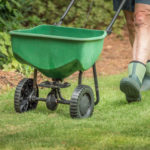The Northeastern Regional Turf Fertilizer Initiative, completed in January of 2014, facilitated meetings to develop mutually agreeable and scientifically sound regional guidelines related to the formulation and application of turf fertilizer.
The goal is to minimize the contribution of fertilizers applied to lawns to polluted runoff and water quality problems.

The final result of this project is the Regional Clean Water Guidelines for Fertilization of Urban Turf describing the 33 guidelines developed through this process. For convenience, the report is also available in a short-form list.
U.S. EPA estimates that roughly half of the nation’s water bodies suffer from some level of water pollution caused by excessive amounts of the nutrients nitrogen and phosphorus entering waterways. This type of water pollution is often characterized by unsightly algae blooms, which look and smell unappealing and also upset the ecological balance of lakes and streams.
Long Island Sound, Lake Champlain, and the Charles River are a few high-profile examples of waters of the Northeast that are highly affected by nutrient pollution. No matter where you live, however, there’s a good chance that you’ve seen a local pond, lake, stream or bay that faces a nutrient problem.
In the majority of cases, polluted runoff is the primary source of nutrients to our waters. When it rains and when snow melts, the rain or melt water picks up pollutants as it travels across developed land areas and farms. Eventually, this runoff will enter a storm drain, which empties into a local water body.
When homeowners or professional landscapers apply too much fertilizer on lawns, and when they apply fertilizer while the ground is frozen or right before a heavy rain storm, nutrients in the fertilizer are carried in runoff to the nearest body of water. There, nutrients over-feed algae, contributing to problematic algae blooms and the declining health of our lakes, rivers, and bays.
NEIWPCC worked with water program directors and technical staff from all seven of its member states and EPA New England to develop the initiative and to identify and engage stakeholders. A list of participating stakeholder entities is available.
Resources
During the course of working on regional guidelines, NEIWPCC learned that there is a wealth of information already available about best practices for turf fertilization. The links below provide legal and technical resources related to lawn care practices that promote clean water. Have a resource you’d like shared here? Please email it to us.
State Laws
Connecticut Public Act 12-155 – An Act Concerning Phosphorus Reductions in State Waters
Massachusetts Acts of 2012, Chapter 262 – An Act Relative to the Regulation of Plant Nutrients
New Hampshire House Bill 393 – An Act Relative to Effluent Limitations with Regard to Nitrogen and Phosphorus
New York State’s Dishwater Detergent and Nutrient Runoff Law, July 15, 2010
State of Vermont’s Act Relating to the Application of Phosphorus Fertilizer to Nonagricultural Turf
NEIWPCC Summary of Regional Turf Fertilizer Laws
Comprehensive Turf Fertilizer Guidance
University of Connecticut, New England Regional Nitrogen and Phosphorus Fertilizer and Associated Management Practice Recommendations
University of Massachusetts Cooperative Extension, Best Management Practices for Lawn and Landscape Turf
University of New Hampshire Extension, Landscaping at the Water’s Edge
Maine Department of Environmental Protection, Best Management Practices for the Application of Turf Pesticides and Fertilizers
Aeration
Virginia Cooperative Extension, Aerating Your Lawn
Lawn Repair and Overseeding
University of Connecticut Cooperative Extension, Sustainable Landscaping
University of Massachusetts Extension, Lawn Renovation and Overseeding
Lawn Size Estimation
Clemson University Extension, Measuring the Area of a Home Lawn
Mowing and Clippings Management
Connecticut Department of Energy and Environmental Protection, BMPs for Grass Clipping Management
University of Massachusetts Extension, Lawn Mowing
Soil Acidity Correction
Rutgers Cooperative Research & Extension, Managing Soil pH for Turfgrass
Soil Testing
University of Connecticut – Soil Nutrient Analysis Laboratory
University of Maine – Analytical Laboratory and Maine Soil Testing Service
University of Massachusetts Extension – Soil Sample and Plant Tissue Testing Laboratory
(serves residents of Massachusetts and Rhode Island)
University of New Hampshire Cooperative Extension – Soil Testing Service
Cornell University – Cornell Nutrient Analysis Lab
(serves residents of New York State, New Hampshire and Vermont)
University of Vermont – Agricultural and Environmental Testing Laboratory
Spreader Calibration
Penn State University, Calibrating Your Fertilizer Spreader
Industry Stakeholders:
- Turf fertilizer manufacturers (conventional and organic)
- Turf fertilizer retailers
- Landscape professionals and associated trade groups
- Golf course superintendents and associated trade groups
Non-industry Stakeholders:
- U.S. EPA and the state environmental agencies
- Municipalities
- University extensions and other agronomy experts
- Watershed groups and other non-government organizations
- Wastewater residual land applicators
- Homeowners associations
- The development community
- Do-it-yourself fertilizer users
Stakeholder Meeting 4
Regional Water Smart Guidelines for the Use of Turf Fertilizer
Date: March 26, 2013
Stakeholder Meeting 3
Topic: Regional Water Smart Guidelines for the Use of Turf Fertilizer
Date: March 12, 2013
Summary: Combined Summary for Meetings 3 & 4
Stakeholder Meeting 2
Topic: Formulation and labeling of natural, organic and biosolid based turf fertilizers sold at retail
Date: May 31, 2012
Summary: Summary of Meeting 2
Stakeholder Meeting 1
Topic: Formulation and labeling of synthetic turf fertilizers sold at retail
Date: May 30, 2012
Summary: Summary of Meeting 1
During the fall of 2013, NEIWPCC opened a comment period for stakeholders to submit written comments on an interim final version of the report and guidelines. A small number of comment letters were received. NEIWPCC developed a single response to comments addressing the concerns raised by commenters, both through comment letters and via telephone or other private communication. The response also describes how aspects of the final report and guidelines were changed in response to comments.
Accolades: NEIWPCC’s Clair Ryan and Michael Jennings have received EPA Environmental Merit Awards for their work on the Northeast Voluntary Turf Fertilizer Initiative. Read the press release.
